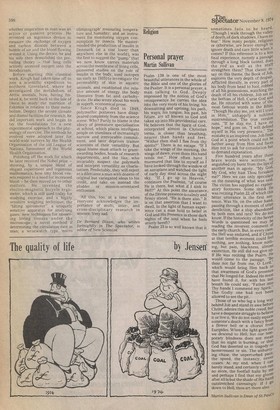Scientific potterer
Bernard Dixon
A hundred years ago next week, on November 15, 1874, one of my heroes was born. His name was August Krogh, 'and he was one of the last of the great scientific potterers — that remarkable galaxy of men who poked about in numerous areas of science and, apparently effortlessly, made historic contributions in them all. A contemporary of J. B. S. Haldane, perhaps the best-known Potterer of all time, Krogh pioneered important work in many different fields, including human physiology, marine biology, nutrition, botany, cell biology, and biochemistry.
August Krogh seems to have been a competent but unremarkable schoolboy at Grenaa, Jutland, and said in later life that his real education took place outside of school hours. He was a dedicated boy scientist, studying insects and spiders, making novel apparatus, and spending considerable time in the field botanising and zoologising. After a false start, when he enlisted for the navy, he went in 1893 to study physiology at the University of Copenhagen.
Immediately, he began making important, original contributions to science. While studying the way in which mosquito larvae regulate their buoyancy, as a fish uses its swim bladder, he invented a new and highly sensitive method for analysing air bubbles. He then applied the concepts and techniques of physics to a wide variety of biological problems — including the rising of sap in stems, the swelling of plant cells, and changes of pressure in animal body fluids. To a large extent, plant and animal physiology have progressed by using just the sort of methods he, pioneered.
Krogh gained his doctorate in 1903 for research in which he established that frogs take up oxygen mainly through the lungs, but lose carbon dioxide by diffusion through the skin. In 1905, the year he married, he became interested in a controversy then raging as to
whether respiration in man was an active or passive process. He invented an ingenious device to measure the exchange of oxygen and carbon dioxide between a bubble of air and the blood flowing around it. Using the device, he and his wife then demolished the prevailing theory — that lung cells actively secreted oxygen into the bloodstream.
Before starting this classical work, Krogh had taken time off to join a scientific expedition to northern Greenland, where he investigated the metabolism of Arctic animals. Now, having finished it, he went back to the Isle of Disco to study the nutrition of Eskimos in relation to their metabolism. Despite the severe climate and dismal facilities for research, he did important work and began to lay the foundations for a new experimental approach to the physiology of exercise. The methods he evolved were adopted later for world-wide surveys by the Health Organisation of the old League of Nations, forerunner of the World Health Organisation.
Polishing off the work for which he later received the Nobel prize — showing, by a unique blend of elegant experiment and ingenious mathematics, how tiny blood vessels respond to a need for increased blood — he then moved on to other matters. He invented the electro-magnetic bicycle ergometer, which is still used today for studying exercise, and a highly sensitive weighing technique; the "tilting spirometer'", a uniquely sensitive apparatus for analysing gases; new techniques for observing living tissues under the microscope; a novel method if determining the circulation rate in man; a wristwatch type 'micro climatograph' measuring temperature and humidity; and an instrument for monitoring oxygen consumption by insects. He masterminded the production of insulin in Denmark (at a cost lower than anywhere else in the world), was the first to suggest the "pump" that we now know carries materials across the membrane of living cells, pioneered studies on the role of insulin in the body, used isotopes (as early as 1935) to investigate the permeability of skin in aquatic animals, and established the relative amount of energy the body liberates from fat and carbohydrate. He also wrote about his work in superb, economical prose.
Since Krogh died in 1949, polymathic potterers have disappeared completely from the science scene. Why? Partly to blame is the idiocy of premature specialisation at school, which places intelligent people on tramlines of increasingly narrow and irrevocable commitment, and later deprives trainee scientists of their versatility. But equal blame must attach to grantawarding bodies, heads of research departments, and the like, who invariably suspect the polymath and interpret versatility as charlatanism. Predictably, they will reject as a dilettante a man with dozens of original but variegated ideas to his credit, and take on instead the plodder or mission-orientated enthusiast.
All this, too, at a time when everyone acknowledges the importance of multi, inter-, and cross-disciplinary research in science. Very sad.
Dr Bernard Dixon, who writes fortnightly in The Spectator, is editor of New Scientist



































 Previous page
Previous page